If thinking about how to calculate freight shipping costs give you a headache, you aren’t alone. Rising shipping expenses, both international and domestic, have many small and large business owners anxious to find ways to save. Saving on shipping expenses is not a one-size-fits-all solution. The type and amount of goods you ship should factor in to find the best solution for your needs.
The National Motor Freight Traffic Association (NMFTA) and the Federal Motor Carrier Safety Administration (FMCSA) both influence the way freight shipping costs are calculated. The NMFTA assigns Freight Class ranks to LTL shipments to standardize pricing. FMCSA regulations set limits on drivers and goods which affect costs.
Find out more about freight shipping calculations to make the best decisions when electing carriers to handle your items.
There are two common choices for shipping large freight in the United States. FTL refers to Full Truckload transport. An entire trailer is dedicated to one shipment or good. LTL is Less-Than-Truckload transport where goods from different shipments may share trailer space.
Pricing for FTL and LTL follows different paths. While many make the argument that LTL shipping is less expensive, it’s not the case all the time. Amounts, distances, and materials all affect the quotes you receive from carriers. Before getting a quote, however, it's a good idea to calculate an estimate so you know what to expect.
Calculating a basic shipping rate isn’t hard. Having estimates on hand is a good business practice. However, be aware that these will just be estimates. True costs take into account other factors and these need consideration when selecting carriers.
Learn more about FTL and LTL shipping by reading our article, “FTL vs. LTL Freight Shipping: What’s the Difference?”
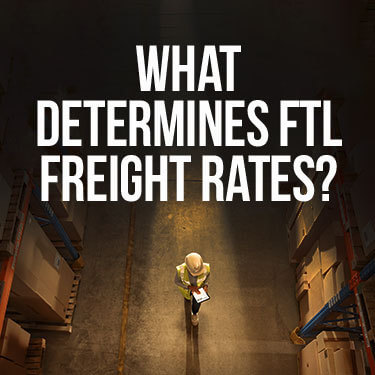
FTL freight shipments have a reputation for simple but expensive pricing. Initial pricing for FTL shipping rates is based on destination and mileage. Since the goods inside the trailer (or on a flatbed) will belong to just one shipper, they can travel non-stop to their destination.
Of course, nothing stays simple for long. Other factors play a role in determining FTL freight rates, but let’s start with the basics.
The base calculation that carriers use to determine FTL works on a price-per-mile system. Sometimes called a per-hundred weight charge (CWT), shippers can look up the average price-per-mile and estimate a freight shipping cost base amount.
Calculate your estimate based on the type of trailer your goods will be transported in. Different trailers vary in terms of cost. There are three common types of freight trailers.
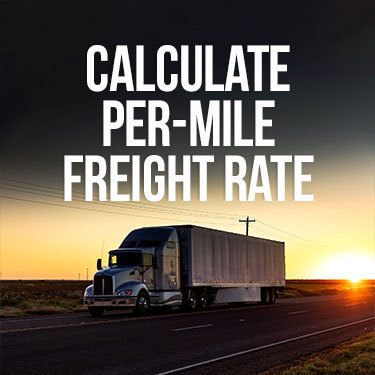
Reefer freight is going to be the most expensive. Refrigerated trailers must have their temperature monitored and the goods they carry are time-sensitive. The price per mile charged by carriers will also depend on fuel costs, tolls, and standard maintenance needs for trucks.
When a food processing plant in Wichita, Kansas needs to ship a trailer of beef cuts to Chicago, Illinois, the distance is roughly 710 miles. Assuming an average rate of $3.19 per mile for a reefer trailer, the base price should be about $2,250.00
| Distance | $ Per Mile | Base Average (rounded) |
| 710 miles | $3.19 | $2,250.00 |
A base average calculated on your own is good for a freight shipping estimate. However, it’s only meant to be a starting point for your shipping calculations. Changing diesel fuel costs often affect the final rate.
Should a carrier provide you with a flat rate, you can still figure out the freight rate per mile. Divide the total rate by the route mileage and you’ll get the per-mile freight rate.
You need to transport goods from Miami, Florida to Nashville, Tennessee - a 915-mile journey. A carrier quotes you a $3,500 flat rate.
| Flat Rate | Distance | Freight Rate Per Mile |
| $3,500.00 | 915 miles | $3.83 |
The carrier is charging you about $3.83 a mile for the trip. If it is a flat rate, it may include fuel calculations. By doing the math when you receive the quote, you can determine how much higher or lower they are than average.
As with figuring out a base average, this should not be used as an absolute number. It is a tool to provide you with a benchmark when budgeting for shipping needs. Other factors, known as accessorial charges, influence the final total; some you can control and some you can’t.
Accessorial Charges may include:
Assigning a specific or consistent number to any of these services for a freight shipping estimate is difficult. These factors change often, and the impact on the cost of freight will not be universal across the industry.
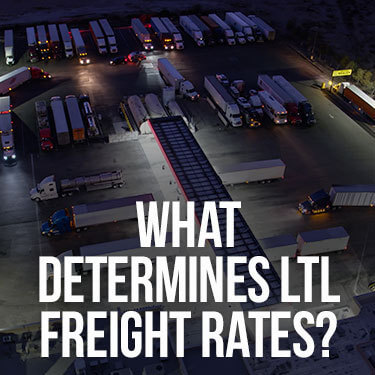
LTL freight rates are credited with being less expensive than FTL rates. This is mostly due to the fact that the nature of LTL shipments is to have more than one load in a trailer. This allows everyone using that trailer for shipping to share the travel expenses among them. Distance calculations are also less important.
Instead, LTL freight rates are determined using the dimensions and density of a shipment. The cubic inches of a shipment are calculated using the height, width, and depth measurements of a fully prepped package, often a pallet. When converted to total cubic feet, they determine the space a shipment will take up. Calculate density using total cubic feet and weight.
Density is the greatest determining factor, so a system was created to standardize costs to ship based on it. The denser a shipment is, the less expensive it will be to ship through LTL services.
The NMFTA developed LTL Freight Class as a standard unit of measurement based on density. Along with three other metrics, freight class gives shipments a ‘transportability’ rating. There are 18 different levels that go from most to least dense.
The highest density ranking, class 50, is also the least expensive. It goes to class 500 which is the most expensive and has the lowest density.
Freight Class and the NMFTA’s National Motor Freight Classification (NMFC) numbers work together in determining final rates.
Check out our article on LTL Freight Classes for an in-depth look at how freight class affects shipping.
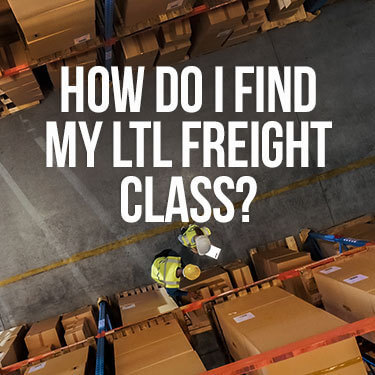
An LTL Freight Class designation can be found by measuring a package’s shipping dimensions and weight to find density. The density is the first measure used to determine freight class, but it isn’t the only measure. Like the FTL rate estimates, freight class calculations are only guesstimates.
Use the following equations to begin your estimate. First, find cubic feet. Once that is calculated, you can find the density by also using the weight.
Using those equations, we can estimate the freight class of a pallet that measures 4 feet by 4 feet by 3 feet and weighs 100 pounds.
| Height x Width x Depth (inches) | Divide by total inches in a cubic foot | Cubic Ft. |
| 48 x 48 x 36 | 82,944 / 1,728 | 48 ft³ |
| Weight of Shipment (lbs) | Cubic Ft. (ft³) | Density |
| 100 | 48 | 2.083 lbs/ft³ |
The resulting density - 2.083 lbs/ft³ - would place it in freight class 250. The table below shows the 18 different freight class rankings and their relative density ranges.
| LTL Freight Class | Density* |
| Class 50 | 50+ lbs |
| Class 55 | 35 - 50 lbs |
| Class 60 | 30 - 35 lbs |
| Class 65 | 22.5 - 30 lbs |
| Class 70 | 15 - 22.5 lbs |
| Class 77.5 | 13.5 - 15 lbs |
| Class 85 | 12 - 13.5 lbs |
| Class 92.5 | 10.5 - 12 lbs |
| Class 100 | 9 - 10.5 lbs |
| Class 110 | 8 - 9 lbs |
| Class 125 | 7 - 8 lbs |
| Class 150 | 6 - 7 lbs |
| Class 175 | 5 - 6 lbs |
| Class 200 | 4 - 5 lbs |
| Class 250 | 3 - 4 lbs |
| Class 300 | 2 - 3 lbs |
| Class 400 | 1 - 2 lbs |
| Class 500 | <1 lb |
An official freight class can only be set by the NMFTA because there are three other metrics considered beyond density.
These metrics are used by the Commodity Classification Standards Board (CCSB) which is a division of the NMFTA. After they make a decision, items get a National Motor Freight Classification (NMFC) code. Carriers who are members of the NMFTA have access to the catalog of NMFC numbers maintained for all shipments within the United States.
Private businesses can also access this catalog through the NMFTA’s ClassIT® tool, available for a one-time fee or as part of a subscription service.
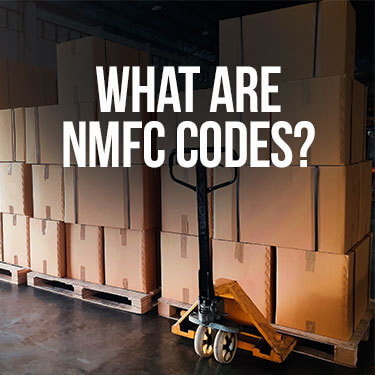
The NMFC number, mentioned earlier, is a five to six-digit code given to specific products shipped around the United States. Use an NMFC code to find an item’s specific LTL Freight Class if it has one.
Shippers and carriers should also be aware that an item’s NMFC code can and does change. As new products are introduced to the market and new ways of packaging are used, NMFC codes are analyzed for accuracy.
Another part of the NMFTA, the Freight Classification Development Council (FCDC) collects information on different items that seem to need adjustment. The CCSB is the group that analyzes the data to see if new codes are needed or to discontinue old codes.
The cubic capacity rule is a carrier’s way of making up costs when shipping large dimension, low-density objects. Often added as a surcharge to a freight bill if applicable, it can be the source of hefty fines on top of the standard shipping service.
Because density places such a large role in determining fees, most carriers have a minimum density requirement in place. This is the Cubic Capacity Rule, sometimes called density deficit.
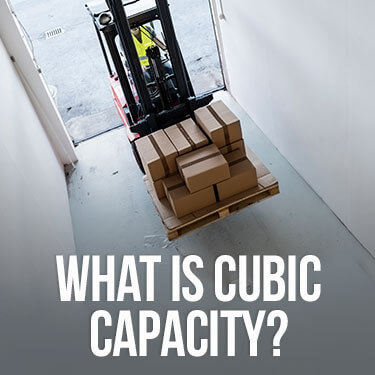
This isn’t a rule set by the NMFTA. Individual carriers may set their own limits. Always double-check with the carrier you plan to use for your shipments. Most carriers will state that any shipment filling more than 750-cubic feet and with a density of less than 6 lbs/ft³ may face a surcharge for density deficit.
Although lower density items do pay more, once they take up a certain amount of space, the extra becomes a null profit. LTL carriers rely on the ability to take on multiple shipments. If a large, low-density shipment is taking up space that could otherwise go to a better-paying load, the carrier is going to want to make money one way or the other.
This rule only affects LTL shipments, not FTL. In some cases where the cubic capacity rule cannot be adjusted, shippers may be better off using an FTL service.

Cubic capacity may come as a surprise to shippers who made sure to measure their palletized cargo for estimate purposes. It is possible for an individual pallet to meet the minimum capacity while a group of the same pallets does not. This is because carriers calculate the shipping rate based on the combined density of someone’s entire shipment, not pallet by pallet.
Imagine you are preparing a pallet of flat-screen televisions for shipping. Because of the product, nothing can be stacked on top. It's very likely the carrier will measure the height of your shipment at 96 inches, the standard height of a trailer since the space can no longer be used.
Therefore one pallet will measure 96” x 48” x 48”. It weighs 400 pounds.
One pallet is safe. It would be smaller than the 750 ft³ minimum. However, suppose you need to stock up on several televisions. You arrange for 6 pallets of televisions, all packaged the same way.
| 1 Pallet | 4 Pallets | 6 Pallets |
| 128 ft³ @ 3.125 lbs/ft³ | 512 ft³ @ 3.125 lbs/ft³ | 768 ft³ @ 3.125 lbs/ft³ |
| SAFE | SAFE | FEE |
One pallet or four pallets would be fine. Shipping six pallets would trigger the cubic capacity fee and land you with extra fees. Cubic capacity surcharges aren’t the same across U.S. carriers. Depending on supply and demand, a carrier may change its minimums at any time. Staying informed about such changes is necessary to avoid surprises.
Even if you consistently ship with the same company, always check for cubic capacity. Consider the example above.
Perhaps your business consistently shipped four pallets at a time, and always packaged the same way. No extra charges would ever be added. The one time you fall behind and decide to order the extra two pallets, you get charged for cubic capacity because you didn’t think to check ahead of time.
If you conduct your shipping through a 3PL warehouse, it’s possible they are familiar with this rule and may warn you ahead of time. A good 3PL will also have packaging procedures designed with LTL freight class in mind. Packing for the highest possible density may help customers pay lower LTL rates.
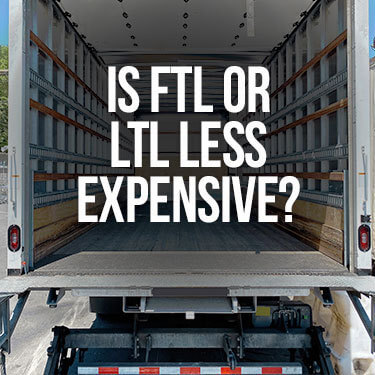
The answer to which is more expensive, FTL or LTL, all depends on one other question. What are you shipping?
LTL is often the choice for heavy items that can be packed tightly or easily stacked. Items that can be moved easily on and off a trailer do better in LTL shipping, which makes frequent stops and requires packages to be loaded on and off. Non-perishable items or merchandise that is part of a regular delivery also tends to be less expensive when shipped through LTL. Many carriers also offer deferred LTL rates to make payments more affordable.
If you need to ship goods in bulk (15 pallets or more) or your goods have non-standard dimensions, FTL might be the only option as well as the less expensive one. A construction company that fabricates roof trusses likely needs the services of an FTL flatbed because the material won’t fit into a trailer. Bulk orders of industrial HVAC equipment likely need an entire trailer. LTL just wouldn’t make sense.
All else being equal, there are factors beyond distance, weight, or density that affect freight shipping calculations.
Any of the factors mentioned above can affect both FTL and LTL freight rates. How much they impact pricing will vary from carrier to carrier.
In reality, neither FTL nor LTL may be best. Another option is partial truckload (PTL) shipping. Like LTL, it takes multiple loads, but the difference is that all the loads are likely to have a common destination.
Before you make any final decisions, examine your average shipping needs. Realize that what works for one delivery may not work for the next. Changing industry circumstances may require a greater amount of flexibility on the part of the shipper and the carrier.
Don’t be confused about how to calculate freight shipping costs; let the experts at USA Truckload help. Powered by R+L Global logistics, our services are backed by decades worth of experience in the industry.
Whether you need FTL or LTL shipping, our fleet can get your goods where they need to go while you monitor them in real-time.
Our trucking services include:
Get a quote today and do the best for your business shipping needs by working with a carrier that won’t let you down.
R+L Global Logistics
315 NE 14th St., Ocala, FL 34470